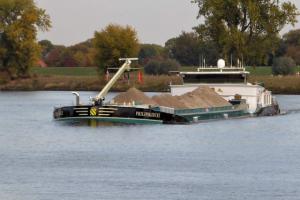"Clients are attaching more importance to sustainable transport"
Johan Faasse, director of Philipskercke B.V., did not hesitate when he read about the CLINSH project and the opportunity to invest in cleaner operations. “I’m doing it for my customers, my business and my children.”
Faasse’s vessel is currently being retrofitted with a post-treatment system: a soot filter and a catalytic converter added to the existing engine. The total cost of these measures, together with equipment to monitor fuel consumption and emissions, is 196,000 euros. Subsidies under the CLINSH project will cover approximately half of this amount.
Investing in the future
“The majority of our clients are in the construction sector. I’ve noticed that many are now devoting far greater attention to the environmental impact of their activities, including the transport of materials. By taking part in the CLINSH project, I want to ensure that my vessel is more environmentally responsible. I am investing in the future of my company and that of my children. We all want future generations to enjoy a healthier environment, right?”
Faasse does not expect an immediate return on his investment in the form of a sudden influx of new orders. But he has no intention of standing idly by. “Projects like this need forward-looking people who are willing to take the lead. We want to be at the forefront of developments. It seems likely that stricter environmental legislation will be introduced in future, making measures like this mandatory. We want to be ready. Moreover, the market will demand greener transport and we must be able to respond promptly.”
A 98% reduction
Last summer, Faasse closely monitored the MS Philipskercke’s fuel consumption and emissions. The engine was modified in late December and the vessel could resume operations in January with its new, cleaner system. “I expect a spectacular reduction in both NOx and PM emissions – up to 98%. I had already invested in measures to reduce CO2 emissions, so I’m now in a very strong position compared to my competitors. I hope that my ‘greener’ vessel will be even more interesting to existing clients and anyone else who needs to transport construction materials. In future, the European Union is likely to introduce even stricter legislation to limit emissions. Bring it on – I’m ready!”
Market value
“Of course, there are commercial considerations when making this type of investment. I hope to attract more clients. But my main motivation is to help achieve a cleaner environment. Someone has to take the lead otherwise nothing will get done. I get satisfaction from knowing that my investment will also benefit society. And the bonus is that my vessel will be worth more if I ever want to sell it.”
Small beginnings
Some operators may be hesitant about making such a significant investment but they too can become more sustainable by installing a simple filter system. For a relatively modest investment, this will vastly reduce emissions – perhaps by as much as 99%. Another way of increasing sustainability is better route planning to ensure that the engine always operates at optimum efficiency. ‘Slow steaming’ is not just for the huge container vessels!
“I have been trying to spread the word but very few of my colleagues who transport construction materials have implemented this type of sustainability measure as yet. They focus on the commercial side and seem to think that they have already invested enough. There is no shortage of work in this sector, so they can continue to do business with clients who are not yet particularly concerned about the environment. They can probably carry on like this for a while but I prefer to take a longer-term view. And I want to do my bit for society,” states Johan Faasse.

